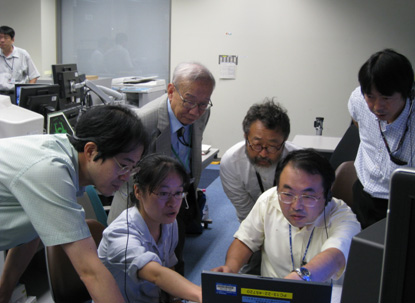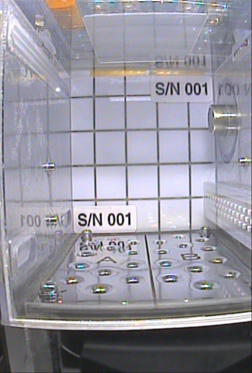This is an archive of information released in the past.
Disclaimer: It may contain broken links or outdated information. Some parts may not function in current web browsers.
*Visit https://humans-in-space.jaxa.jp/en/ for the latest information.

Experiment
- News
- Kibo Utilization Strategy
- Kibo Utilization Plan
- List of JAXA's Utilization Themes
- Experiment Facilities
- Space Environment Utilization
- Archive
JAXA's long-term plant growth experiment, began onboard Kibo
* Dates and times are given in Japan Standard Time (JST)
JAXA's long-term plant growth experiment, Space Seed*1, began onboard Kibo.
*1 Life Cycle of Higher Plants under Microgravity Conditions
(Principal Investigator: Seiichiro Kamisaka, Visiting Professor at Toyama University, Emeritus Professor at Osaka City University)
The Space Seed experiment began at 9:38 p.m. on September 10, shortly after the ISS Expedition 20 Flight Engineer Nicole Stott installed the Plant Experiment Unit (PEU), which contains the plant experiment sample chambers, in the Cell Biology Experiment Facility (CBEF) in Kibo.
This plant growth experiment in space uses Arabidopsis thaliana, known as thale cress, aiming at investigating gravitational effects on the plant's life cycle from seed germination through seed production.
During the in-flight experiment, growing process of the plants germinated from the seeds will be closely observed using a CCD camera equipped in the PEU. Harvested plants and seeds will be refrigerated and or frozen in the Minus Eighty degrees Laboratory Freezer for the ISS (MELFI) as samples to be returned to the ground.
Using the returned samples, germination rate of the space seeds and their growing process will be examined in the post-flight analysis. In addition, strength of the cell walls and the genes involved in the cell wall formation will be analyzed using the plant samples that are harvested in space. Roles of gravity in the lifecycle of plants is expected to be clarified based on the data collected during the experiment, In addition, the data will be utilized in development of plant production technology for future space exploration programs.
The Space Seed is scheduled to continue onboard Kibo until the middle of November, 2009.
Principal Investigator:Seiichiro Kamisaka, Professor
I first met Astronaut Nicole Stott at a training session on the Space Seed held in March 2009. During the training, we provided her details and operational procedures of the Space Seed. I am very glad that her efforts, preparations and training have realized this flawless start of the experiment. I am impressed when I saw her operating the experiment with such ease. Also, I am grateful to JAXA teams and all the people who have involved in the preparations and operation planning of this complicated experiment for realizing this actual in-flight operations.
The experiment will continue the following 60 days supported by JAXA's experiment operation team around the clock in 3-shift / day. I am very excited about overseeing the experiment. It became one of the most memorable moments for us since the Space Seed experiment began on the same day the launch of the H-II Transfer Vehicle (HTV) took place.

Professor Kamisaka (left rear) and the Space Seed team members checking the telemetry of the experiment at the User Operations Area (UOA) immediately after the experiment began

Internal view of the Plant Experiment Unit (PEU) taken with the installed CCD camera: The seeds are planted in the holes on the bottom of the PEU, and water is provided by watering system inside
*All times are Japan Standard Time (JST)
| Copyright 2007 Japan Aerospace Exploration Agency | Site Policy |